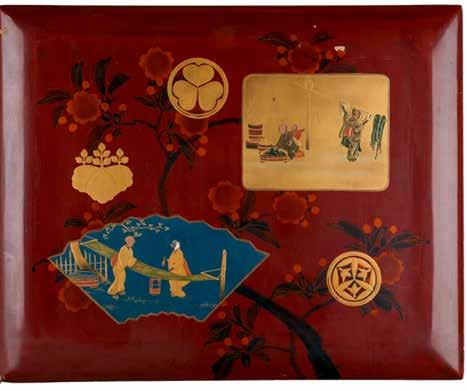The samurai in a modern world
Russell Kelty What Japan was she owed to the samurai. They were not only the flower of the nation but its root as well. All the gracious gifts of heaven flowed through them.1
The restoration of the Emperor and the establishment of his ‘enlightened government’ in 1868 initiated an artistic and cultural revolution in Japan. The Meiji era (1868–1912) is defined by the Japanese empire’s rapid ascension on the world stage due to modernisation and technological innovation. Art was considered an essential part of the government’s ambitions to present Japan as a modern nation and thus avoid the perils of colonisation that had befallen the Qing dynasty (1644–1911). Under the slogan, ‘Enrich the country, strengthen the military’ (fukoku kyōhei), the new government actively encouraged artists to create objets d’art on a par with those of industrialised nations for display at international exhibitions in America, Australia and Europe. This revolution meant the official end of the reign of the shogun, daimyo and samurai. In 1876 the right to wear swords in public was banned, and many young samurai, realising the need for reform to the military and society, gladly cut off their top knots, donned Western clothing and joined the bourgeoisie. In addition to forming the new Japanese military, ex-samurai also became civil servants, teachers, merchants, farmers and artists, enacting a successful self-transformation from samurai estate to modern office holder. The previous function of the samurai was replaced by a conscripted army, who wore Western military uniforms and who were trained by Western experts. Once the top of the social hierarchy, the samurai had now lost their class, privilege and vast estates. The old view of the samurai as a tool of society was transformed: they were now seen as an army which acted as the protective force of the fabric of a society menaced from abroad by real and imagined internal subversion.2 The samurai may well have been deposed, but they cast a long shadow on modern Japan. Authors such as Inazō Nitobe constructed an idealised samurai for Western audiences, with the aim of countering the critical response to Japan’s growing military power in East Asia. Bushidō: the soul of Japan was first written in English and published in Philadelphia (1899) and translated into Japanese in 1909. ‘Bushidō’ literally translates to ‘the way of the warrior’ and is largely based on Western ideas of chivalry rather than on the specific code of conduct conceived during the Edo period.3 Nitobe ‘attributes the foundation and flourishing of the national soul to the samurai ancestors’ and attempted to forge a distinct and unique Japanese identity in order to explain ideals and values from Japan’s past. Bushidō was highly influential in Japan and the West, with presidents such as Theodore Roosevelt (1858–1919) and John F. Kennedy (1917–1963) reading it in an attempt to understand the new rising power. 76
1 Inazō Nitobe, Bushidō: the soul of Japan, Cosimo Classics, 2007, p. 67. 2 L.M. Cullen, A history of Japan, 1582–1941: internal and external worlds, Cambridge University Press, Cambridge, 2003, p. 261. 3 Cullen, p. 266.

















